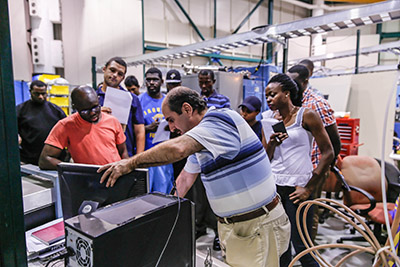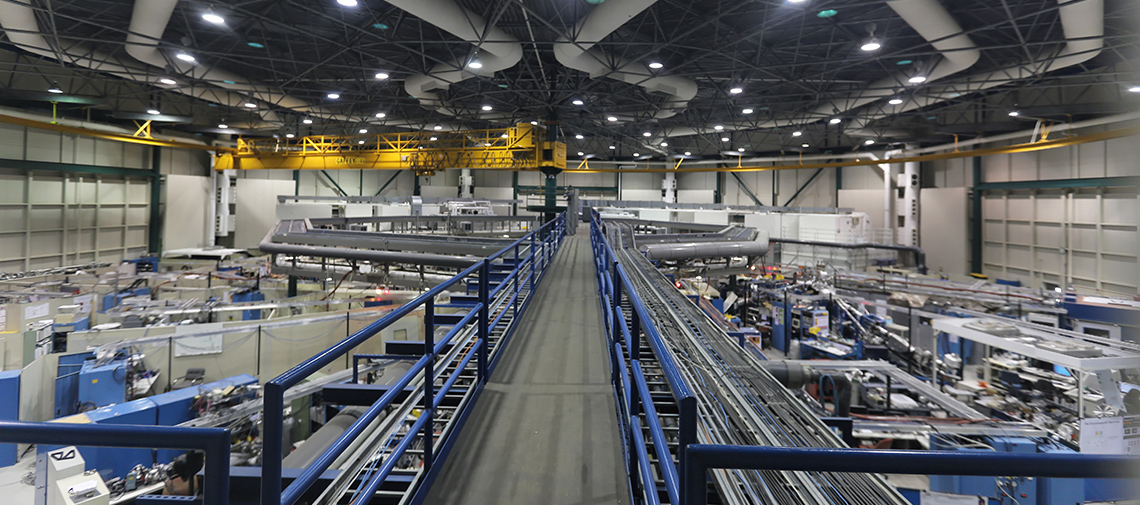Louisiana's Premier Facility for Synchrotron Radiation Research

Students from Southern University and A&M College tour CAMDPhoto provided by CAMD
LSU is home to one of the most advanced technologies that any scientist could ask for. The J. Bennett Johnston Sr. Center for Advanced Microstructures and Devices, or CAMD, houses the only state-funded synchrotron radiation research center in the U.S.
With only seven synchrotron radiation facilities in the U.S., CAMD is bringing cutting edge capabilities to LSU. While this facility provides many other tools that can be used for research, the star is the 1.3 Ge electron storage ring that is used for synchrotron radiation. This one piece of equipment attracts people worldwide.
The electron storage ring, put simply, accelerates electrons to nearly the speed of light. When the electron’s trajectory is bent by a magnetic field, it emits synchrotron radiation – a really bright light, about a million times brighter than the sun. Built to pursue science research and discovery, CAMD has attracted physicists, chemists, geologists, and biologists from Brazil, Japan, and all over Europe.
Anyone is allowed to come and use CAMD whether it be students, faculty or staff. In the past five years more than 120 undergraduate students and nearly 150 researchers from LSU, industry and national labs have utilized CAMD. Richard Kurtz, LSU physics professor and interim CAMD director, said that one special aspect of CAMD is that students can be trained in these advanced STEM scientific techniques as opposed to other facilities where limited access also means limited training.
Most of the faculty and staff that come to do research at CAMD use the light produced by CAMD’s synchrotron radiation for research and experiments to characterize various materials. The CAMD facility produces a broad spectrum of light which differs from normal x-ray machines that produce a limited spectrum. At CAMD, researchers are able to use all kinds of light ranging from visible light, to infrared light, all the way to hard X-Rays. Because of the range of light the synchrotron produces, CAMD attracts all types of scientists to use it for their research.
Marcia Newcomer, George C. Kent Professor in LSU's Department of Biological Sciences, studied enzymes by using the x-rays produced by CAMD. By utilizing the light at CAMD, Newcomer was able to determine the 3D structure of molecules.
The synchrotron light created at CAMD is used in four major research areas: for energy, for the environment, for biomedical research and for microfabrication. First, synchrotron light can be used for energy discovery and development. Synchrotron light has been used to find new ways to develop catalysts that engineers can use to create liquid fuels from gases like CO2.
Secondly, synchrotron light can be used to measure, manage, and characterize the amount and kinds of toxic waste being released into the environment. In other words, CAMD can be used to help understand and remediate environmental issues. In many cases the experiments done at CAMD for environment and energy research overlap.
Thirdly, synchrotron light can be used to develop new medical and biomedical techniques. Biologists come to CAMD to figure out how a molecule functions in its purest form. Some biologists come to get a better understanding of the structure of proteins and enzymes using CAMD’s high-powered X-Rays, and knowing these structures they can develop new drugs that can change their function. In another application, the LSU medical physics research team is working to develop a more effective technique for cancer therapy using X-rays.
Lastly, this light can help better understand the process of making micro machines. CAMD has transformed machines the size of a dinner table to the size of a thumb. Physicist and Nobel Laureate David Wineland even uses a CAMD microstructure in his research to build better atomic clocks and to find new methods for quantum information storage. With the growing discovery and technology of nanoscience and nanotechnology, CAMD is also being used as a nanofabrication facility.
With an annual operating budget of just over $3 million, CAMD opens new opportunities for LSU faculty to be funded by academic grants, state and federal funds and industry contributions. In 2014, LSU Chemistry Professor Les Butler was awarded a $500,000 grant from the Keck Foundation to develop a new method of X-ray imaging. It is grants like these that keep LSU and the state on the forefront of science and technology.
The center has flourished despite budget cuts sustained when the economy faltered. CAMD has made significant contributions to Louisiana’s economic development due, in part, to the start-up companies that emerged from CAMD research. There have also been industrial users from more than 15 companies attracted to CAMD’s facility including Exxon Mobil, Sasol and Albermarle. CAMD is currently staffed by 23 people who operate the accelerator, but also take time out of their day to give tours to the general public. Many tours are given to children from schools around Louisiana for educational field trips.
CAMD's reach has also extended beyond research to have an impact on today's popular culture. The center made its theatrical debut last summer in the Marvel classic “Fantastic Four.” The facility was used as the location for Baxter Labs, the meeting place and laboratory for a child prodigy before the team was transformed into the “Fantastic Four.” Since its appearance in the movie, other filmmakers have expressed interest in using the facility in upcoming productions.
CAMD has made its impact internationally as well. In 2012, the center hosted and organized the International Particle Accelerator Conference, or IPAC, an annual conference where scientists from across the world come to interact and exchange ideas about research and accelerator technology. It was a perfect fit for CAMD to host. After establishing a long term commitment to this scientific organization, the staff at CAMD was able to host IPAC in New Orleans, making it the first IPAC conference held in the U.S.
The impacts of CAMD are immeasurable. Since its creation, the center has helped advance the careers of numerous LSU faculty, solidify industry support and expand the university's economic impact in Louisiana. For the professors at LSU, CAMD’s proximity to campus makes it a valuable tool that can be used for research without having to travel across the country.
“It’s easy access to a state-of-the-art data collection facility,” said Newcomer.
CAMD’s efforts have made LSU a much more competitive school, by continuously improving its reputation and contributing to the world of research and science.
